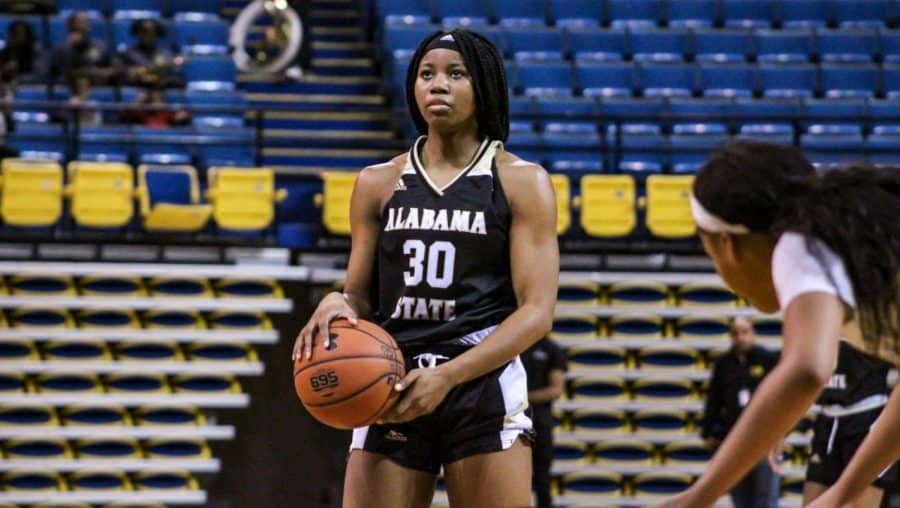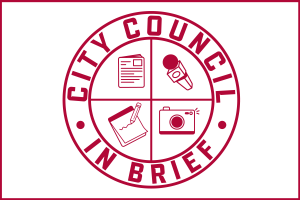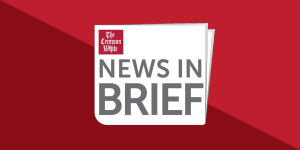It’s time to put HBCU athletes in the spotlight
Courtesy of Alabama State Athletics
Pictured: Aniyah Smith
October 21, 2021
Athletes at historically Black colleges and universities receive less attention than athletes at predominantly white institutions despite being just as talented.
The 2021 NFL draft was the ninth time since 2000 that no players were selected from an HBCU. In 2020, only one HBCU player was selected in the NFL draft.
Athletic programs at HBCUs receive less national media exposure, funding and support compared to athletic programs at PWIs.
The Southwestern Athletic Conference is made up of HBCUs in the Southern United States. SWAC games are broadcasted on national TV less than other collegiate athletic conferences. This limits the amount of national media coverage HBCU athletes receive.
Tampa Bay Buccaneers cornerback Cameron Kinley has a lot of respect for HBCUs despite attending the U.S. Naval Academy.
“I definitely think HBCU athletes are left out of the media spotlight,” said Kinley. “Games aren’t often broadcasted on TV, and it is harder to get national exposure.”
Only one SWAC game is scheduled to be broadcast on ESPN this year. There are two SWAC games scheduled to be broadcast on ESPN2.
Jacksonville Jaguars offensive tackle Will Richardson, Jr. said a lack of media coverage negatively impacts HBCU athletes.
“Making it to the NFL is about exposure,” said Richardson. “One way I believe the media can help is by broadcasting more HBCU games on national television.”
Despite the challenges HBCU athletes face, some athletes decide to transfer from a PWI to an HBCU. Some of these students have said there is a noticeable difference in the support that HBCU athletic programs receive compared to PWIs.
Former Missouri State basketball player Dariauna Lewis transferred to Alabama A&M University to improve her mental health and connect with her roots. Lewis is second in the NCAA for rebounds per game and is a leading player of multiple categories in the SWAC.
“A narrative that needs to be changed is that Black kids go to HBCUs because they can’t get into bigger Power Five schools,” said Lewis. “I transferred from a big DI program, so I am a walking example that we can get into bigger schools.”
Former West Virginia cornerback Tacorey Turner transferred to Alabama A&M because he wanted a different cultural experience.
“Give HBCU athletes more exposure like athletes received at my previous PWI,” said Turner. “HBCUs should also get more credit and attention in the media.”
HBCUs are historically underfunded. From 2010 to 2012, 61% of HBCUs in America did not receive their full state funding, according to a report by the Association of Public and Land-grant Universities.
Underfunding makes it harder for HBCUs to get resources and attract top recruits.
Alabama State University baseball player Jayden Sloan would like to see more top recruits make the decision to play at HBCUs.
“Top recruits going to HBCUs will contradict the narrative that athletes only choose HBCUs because they didn’t have another option,” said Sloan. “I believe top recruits deciding to come to HBCUs will help bring in more funding for athletic programs.”
Alabama A&M sprinter Nicholas Powell said he is excited to see top recruits beginning to choose HBCUs over PWIs.
“It’s sad that athletes have to make the sacrifice right now to see HBCUs prosper in the future, but it’s extremely courageous of them,” said Powell. “The decision to come to an HBCU over a PWI as a big-name athlete will literally affect generations to come.”
This story was published in the Legacy Edition. View the complete issue here.





















![NEWS | The University provided the UA Young Americans for Freedom chapter an exception to a required non-discrimination clause for student organization constitutions that prohibits barring membership based on characteristics of personal identity.
The exception for the conservative political organization allows it to use a modified version of the required non-discrimination statement excluding wording prohibiting discrimination based on a student’s “gender identity, gender expression, [or] sexual identity.”
“We were not about to be bullied by this new gender ideology cult infecting the University of Alabama administration,” Trenton Buffenbarger, president of UA YAF, said in an article on the YAF website.
After UA YAF applied to renew its organization with The Source, an annual requirement for student organizations, the Source rejected the application. A University employee stated in an email reply to UA YAF that it was required to include a nondiscrimination clause in its constitution with the “EXACT” wording, noting that UA YAF would remain in “frozen status” until it complied.
The chapter pushed back against this required clause, as it included references to gender identity and sexual identity.
Buffenbarger said in an interview with The Crimson White that he saw this as an attack on “basic free-thinking students,” adding he believes that welcoming in someone who not only fundamentally disagrees with the organization on “ideology,” but encourages the opposing ideology, is wrong.
“UA tried to force us to not only comply, but to explicitly put something we disagree with in writing in our constitution,” Buffenbarger said. “It is a violation of the First Amendment.”
📸 CW / Riley Thompson
🖊️ CW / Cameron Cortez
Read the full story at the link in our bio.
#theuniversityofalabama #universityofalabama #alabama #uofa #ua #crimsontide #rolltide #tuscaloosa #tuscaloosaalabama #alabama #bama](https://scontent-ord5-2.cdninstagram.com/v/t51.75761-15/482193306_18487676404025566_4501943912441479788_n.jpg?stp=dst-jpg_e35_tt6&_nc_cat=102&ccb=1-7&_nc_sid=18de74&_nc_ohc=nBshcYUJ7DUQ7kNvgFCbrLa&_nc_oc=Adm6i_gRdHsBC4jCUTUoIm4DUIpF4GOpewI9A9YrSPUzXJnjlZ9xxTxuEnwHLkYpKUE&_nc_zt=23&_nc_ht=scontent-ord5-2.cdninstagram.com&edm=AM6HXa8EAAAA&_nc_gid=O9ipvlFcgvWaPSAq3kJbUQ&oh=00_AYFHeSim1SGjDl_DQsFAWevnNP69yrG6RKbl5njEgCW8og&oe=67E72662)